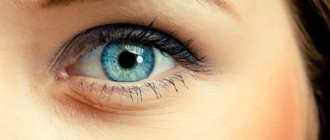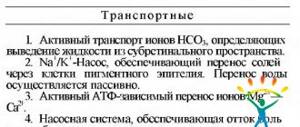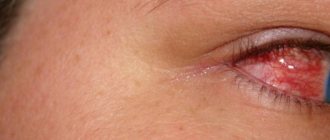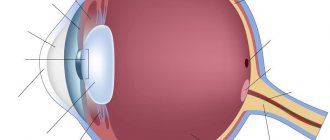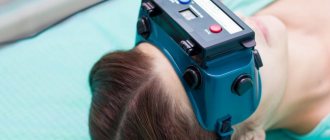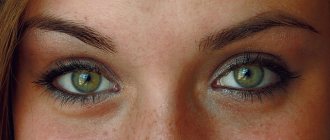The child went to school, and his vision began to be subject to increased stress. If you add to your studies “sitting” on the phone, playing on the computer, watching TV, then the load may be too much for children’s eyes. As a result, a number of ophthalmological diseases occur. The most common of them is myopia.
Therefore, it is worth thinking about the health of your child’s eyes before he develops vision problems. Moreover, for this it is enough to follow a few simple rules.
When and what do newborns see?
First of all, it is worth saying that the ability to see is innate in every person. Most children who have just been born see everything around them as if in a fog, very blurry. This happens because vision gradually begins to adapt to new conditions that were not there before. Therefore, a child’s vision at 1 month is significantly worse than that of a baby who is 4 or more months old.
Newborn babies begin to squint if they see bright light, and prefer to keep their eyes closed more often. However, there are also those children who, from the first hours of their life, prefer to look around everything around them. Although it seems to parents that during this period of time the child’s gaze is quite interested, in fact the baby is unlikely to see anything clearly. To understand this, just look at the photo of how a child sees at 1 month (see below).
It is also worth talking to a doctor who can explain how the optic nerves develop.
First feelings
Information about exactly when a child begins to see is very contradictory. There is an opinion that in the first time after birth, children are half-blind and half-deaf. However, this is not quite true. Indeed, the vision of a baby who was recently in the womb differs from the sense of a one-year-old baby, but this is understandable.
Nature made sure that the newborn gradually adapts to the reality around him. Just imagine: after a dark and pleasant place, with muffled sounds, a child finds himself in a bright, screaming world.
Such an abrupt transition is a serious blow to the child’s psyche. That is why nature made sure that the neural connections connecting the nerve endings of the eyes with the brain were less developed in a newly born child than in an adult.
What does this give to the baby? When a newborn is born, he sees not objects, but their outlines. In the first days after birth, the child does not distinguish colors and cannot determine the volume of objects.
All he can understand is whether it is light or dark now.
Surely you yourself have noticed how your baby begins to squint his eyes in bright light. It is difficult for a newborn to focus his eyes; his eyes constantly move from one object to another.
However, this won't last long. Very soon your baby will understand the benefits he will gain with his new senses. When should we expect change?
How do babies see after birth?
For the first 14 days, newborn babies usually only eat and sleep. Many parents assume that during this period of time children see absolutely nothing. However, experts categorically disagree with this statement, and they assure that a child can see the first images just a few minutes after his appearance in the world.
If we talk about how a child sees at 1 month, then during this period of time the baby sees everything around him very blurry. In addition, it cannot focus clearly on one object. This is due to the fact that the newborn’s eyes gradually begin to get used to the new atmosphere.
A little later, he begins to see at a distance of up to 20 cm. With the onset of 2 months, the ability to focus on a specific object comes, but only for 2-3 seconds. During this period of time, the child is still unable to hold his attention for a long time on a person, toy or any other thing.
By the fourth month of life, the baby can already independently examine interesting objects in his environment and watch how they move. In addition, starting from three months, the child begins to distinguish color schemes. First of all, he sees shades of red and yellow.
By 6 months, the child already sees everything clearly and in bright colors. During this period of time, he begins to recognize his relatives and distinguish them from other family members.
When does a child begin to focus?
By the seventh month of pregnancy, vision is already fully formed. However, after this, some more time is needed for the full development of the brain centers that will be responsible for visual perception to be completed.
Therefore, speaking about how newborn children up to 1 month see, it would be fair to say that they begin to process the picture only from four months. That is why you should not expect much from the child before this period. Until 4 months, the baby can only see two-dimensional images. However, at this stage he does not need more, since he begins to try to focus his gaze on both moving and static objects.
What do newborns look at?
It's no secret that a newly born baby loves to look at the faces of his parents with great curiosity. This is explained by the fact that they are always nearby, and he can see them, at least minimally. As a rule, children are more drawn to their fathers during this period of time, as they can distinguish their beard or mustache.
Based on what a child sees at 1 month of age, it is not recommended to change his appearance, as this may upset the baby. Also, a newly born toddler will look with interest at contrasting pictures, patterns and other shapes. They do not have to be bright, since the child sees only in black and white during this period.
Features of the development of visual organs in infants
The development of all systems of the body of newborns occurs gradually, the organs of vision are characterized by sequential development, at first infants see the world around them in black and white, after 1-1.5 months the vision becomes colorful.
- At first, the eyeballs of babies may move unevenly, the eyes may squint or look in different directions, all this is due to the weakness of the eye muscles; when they get stronger, the appearance of the visual organs stabilizes. If after 2-3 months the situation has not changed, you should consult a doctor.
- Since in the initial 2 weeks of life, babies cannot see and distinguish between different colors, they show interest in visually clear objects - try to surround the baby’s playpen with toys with clear faces, objects without small distracting details, and also spend time with him more often.
- When the baby learns to raise his head (and this will be after 1 month), his vision has not yet fully stabilized. The baby will be able to shift his gaze to the thing that interests him, but he will be able to focus on it for a long time only by the 4th month after birth.
- You can check the correct development of the visual system in a newly born baby by reacting to light; to do this, shine a flashlight into the center of the eye or bring the baby to sunlight, the pupils should narrow.
Remember that any anomalies and malformations can be prevented if you pay attention to them in a timely manner; do not refuse a scheduled visit to the doctor - during the first year, the baby should have 2-3 mandatory meetings with an ophthalmologist.
How to make eye contact with your baby
There are several recommendations that will help you quickly get closer to your child and teach him to recognize his parents. Knowing what kind of vision a child has at 1 month, experts note that in an upright position a newborn baby can focus his gaze much better. Therefore, in order to draw the child’s attention to yourself, you should hold him not in a horizontal, but in a vertical position.
It will also take a few minutes for the child to be able to calmly focus on the parents. The face should be kept at least 25 cm away from the child’s eyes. In order for the baby to quickly begin to recognize various objects, it is recommended to place toys not directly in front of his eyes, but to the side or closer to his feet.
When talking with a child, you need to talk quite slowly and quietly, while smiling, then he will begin to distinguish his relatives much faster, first by the intonation of his voice, and then by external parameters.
1 month old baby: instincts and reflexes
From birth, your baby has several useful developmental skills at his disposal.
Your baby can hear from about halfway through your pregnancy, so she will already be familiar with your voice and will likely find it soothing. There are even some studies that show that any music you listened to a lot during pregnancy can help calm your baby!
At birth, your baby will not be able to see very far, about 20cm from his face. When you hold your baby, this is the ideal distance for him to focus on your face. By the end of the first month of a child's life, he can follow bright objects with his eyes.
Your baby should also have a healthy voice - although his vocal abilities at this stage will mostly involve crying.
Your baby may exhibit some instinctive newborn behaviors, including:
- Moro reflex (or startle reflex). This is when your baby throws out his arms and arches his back if a sudden movement makes him feel insecure or anxious. This often happens when you put them to sleep...causing them to wake up screaming.
- Rooting and sucking reflexes. Your baby will turn and try to suck on the nipple or anything else that is close to his cheek. It's not uncommon for young children to try sucking on their hand, nose or earlobe if it comes their way!
- Grasping reflex. Your baby will wrap his tiny fingers around one of yours.
- Walking reflex. If you gently hold your baby upright with his feet on a flat surface, he will move his little legs as he walks.
These are all very smart things. But these are skills that your child will soon lose. Instead, they will have to learn them all over again from scratch a little later!
Appearance of a newborn baby
You may feel a little alarmed about certain aspects of your child's appearance. Don't worry—newborns have many unusual features, including:
Belly Button What's left of the umbilical cord will dry out and fall off within a few weeks. Meanwhile, you need to keep it clean and dry as it is prone to infection. Keep an eye on the area—if it looks sore, tell your doctor.
Head Newborn babies' heads are often slightly flattened or elongated as they pass through the birth canal. This is especially true if you had an assisted delivery using forceps or a ventouse, which could also leave temporary marks or swelling.
You will also notice that your baby has two soft spots on his head, known as fontanelles, where the bones of the skull have not yet fused together. They gradually close over time.
Eyes In the first hours and days, your baby's eyes often seem to squint. This happens because newborns cannot yet control the muscles around the eyes.
Also, your newborn's eyes often have a coating on them and you can gently wash it off. Tell your doctor if you notice a yellowish tint to your eyes, as this may indicate jaundice. The same thing happens if there is redness or yellow discharge; it could be an infection that needs drops.
You'll probably love looking into your baby's eyes, but did you know that color can change over time? Many babies born with light blue or gray eyes develop a completely different eye color by the end of their first year. This is because the pigment can develop when your baby's eyes are exposed to light.
Dry, Blotchy Skin Newborns have sensitive skin, which can mean all sorts of spots and spots. These can be milia or milk spots, which are very common.
A yellowish tint may indicate jaundice (although in mild forms it is not a cause for concern). There may still be traces of vernix, a fatty protective substance produced in the womb. Don't wash it off: it's a healthy moisturizer.
Birthmarks Every tenth child has a birthmark of some form that develops on the skin before or shortly after birth. Some disappear over time, others remain permanent unless removed. Most are harmless, but some may require treatment for medical reasons. Your midwife should be able to give you advice.
Hair Your baby may have a lot of it...or very little. In any case, they are likely to change in number and color in the coming months. Don't be alarmed if your baby also has a hairy body. They're just remnants of the fine, soft hairs called lanugo that kept them snug during pregnancy, and they're about to disappear.
Nipples and genitals These may be temporarily swollen, caused by your hormones crossing the placenta. The same thing explains the small amount of blood in the girl's diaper. Symptoms should disappear within the first month of your baby's life.
Feeding a 1 month old baby
You've probably already made plans for feeding your baby.
If you are breastfeeding, there is a lot of advice and support available. It may be difficult for the first few weeks, but it gets better and has many benefits for you and your baby, so it's worth persevering if you can.
If you are bottle feeding your baby with expressed milk or formula, there are important hygiene and safety rules to follow.
If you're shopping for a breast pump, check this out. We really like Medela breast pumps, which follow the natural shape of the breast.
Baby's sleep at 1 month
Newborn babies tend to sleep a lot (spending more time asleep than awake), but without any set schedule, anything from eight hours to 16 or 18 hours of sleep in each 24-hour period is normal.
Your baby will likely wake up regularly, both during the day and at night, because he has not yet developed a functioning body clock. Not only that, but your baby has a tiny tummy that needs frequent feedings to keep hunger at bay. So at first you may be able to get up at least four times a night.
No matter how difficult it is, you will adapt. It's just part and parcel of this stage of motherhood.
How to cope with sleep deprivation?
In the first days, it is best to go with the flow. Let your baby sleep whenever he wants for now. Many parents choose to place their newborn in a portable crib or Moses basket, which makes sense since you can move him around the house with you as he naps during the day.
Make the most of this phase when your baby sleeps for long periods of the day.
When should you start your daily routine?
At this stage, it is still a little early to start a formal routine for your baby. They will change so much over the first few months that whatever routine you have set up now will soon fly out the window.
However, there are some positive sleep habits you can start establishing right away. Try to keep lights dim at night, reduce noise and distractions, and speak softly to your child. Over time, this will help them gradually begin to understand the difference between day and night, and that night is for sleeping.
Once your baby is at least three weeks old and healthy and gaining weight normally, you can start delaying feedings for a few minutes when your baby wakes at night.
This short delay means that waking up is not immediately rewarded with feeding. This is done gradually by changing their diaper before feeding. This does not mean that the baby should cry for a long time.
When does a child begin to recognize his parents?
Newborn babies begin to clearly distinguish their mother's facial features starting at 3 months. This is explained by the fact that during this period of time the babies adjust their binocular vision. This means that the child gradually begins to see with both eyes simultaneously and synchronously. To quickly teach him to recognize the appearance of his mother or father, it is recommended to change his facial expressions as often as possible, smile and not talk while looking at him.
Although the vision of newborns at 1 month is not clear, this does not mean that they do not hear or cannot perceive the smells of their loved ones.
Limit gadgets
Sitting on gadgets is a favorite pastime of modern children. Of course, such a pastime cannot be called useful. In addition to “dry eye” syndrome (symptoms: fatigue and redness of the eyes, a feeling of sand in the eyes, difficulty focusing, etc.), excessive use of gadgets can contribute to the development of myopia.
However, you shouldn’t perceive them as absolute evil - you just need moderation in everything. Thus, safe time spent with a gadget for younger schoolchildren is considered to be 40 minutes a day, 70 minutes for older children and no more than 1.5 hours for high school students.
How to determine that a child’s vision has become worse
- Holds a book close to his eyes, sits closer to the TV, computer;
- squints, looking at distant objects;
- often complains of headaches;
- school performance has dropped (the child simply does not see or does not see well what is written on the board, and is embarrassed to sit closer or ask the teacher).
When to start worrying
During a visit to the pediatrician, it is worth talking to the doctors, who, as a rule, checks the vision of a newborn baby. At this time, it is worth telling a specialist about all your concerns. For example, it is worth drawing the therapist’s attention to the baby’s condition if he cannot follow an object with both eyes at once, despite the fact that he is already more than 4 months old.
Another concern should be that the child's eyeballs begin to move in different directions. If the baby is more than 3-4 months old and cannot hold his gaze on one object for a long time, then this may also be a cause for concern.
The same applies if the baby squints or closes his eyes alternately. It must be borne in mind that if a child was born prematurely, there is a high risk that he will have vision problems. That is why in the first weeks of his life it is recommended to visit specialists as often as possible and check him for the presence of astigmatism, myopia and other pathologies.
If we are talking about a healthy newborn, as a rule, a specialist can easily determine how a child sees at 1 month of life.
Dose visual stress
The duration of home lessons for primary school children should not exceed 1 hour, for middle school children – 2 hours. If a child attends additional classes, they should not last more than one and a half hours on school days and 3 hours on weekends.
If there are no vision problems, the student should take a break from classes every 40 minutes, if myopic, every half hour. Moreover, during the break, do not let him sit on the phone, watch TV, play on the computer, etc. - It’s better to let him take a walk on the street.
It’s good if the child does simple eye exercises every day. Such exercises improve blood circulation, relaxing muscles and relieving eye fatigue.
How to check a newborn's vision
As a rule, in order to assess how well a child sees, the doctor uses special flashlights. With the help of a bright directional light, the doctor can assess the reaction of the baby's pupil. If such a check does not give any results, then in this case, you can use special non-contact equipment. In this case, the child will not suffer, since all manipulations are performed in a playful way.
The equipment allows you to determine with the greatest accuracy how a child sees at 1 month and identify possible pathologies.
Tips and tricks
Don't worry if your baby's eyes squint ever so slightly before the age of 6 months. In the process of developing binocular vision, a child can see various objects with both eyes separately. Only at the age of 6 months is the baby able to combine a picture and see it with both eyes at the same time. During this period, the strabismus disappears. However, if this does not happen, you must definitely visit an ophthalmologist.
When communicating with your baby, you should not move suddenly or change the picture in front of him. If a parent wears glasses, then you should not take them off and put them on. During this period of time, any changes in appearance can greatly frighten the baby. It is also worth monitoring the mucous membrane of the child’s eyes. Hairs and other foreign objects should not get into it.
Although at first the baby tries to close his eyes when in the light, you should not hide him in a darker place. The eye muscles must learn to work normally. Therefore, even while the baby is sleeping, it is recommended to use a night light. Toys in a child’s crib should be changed every 2-3 months so that he learns to identify different objects.
